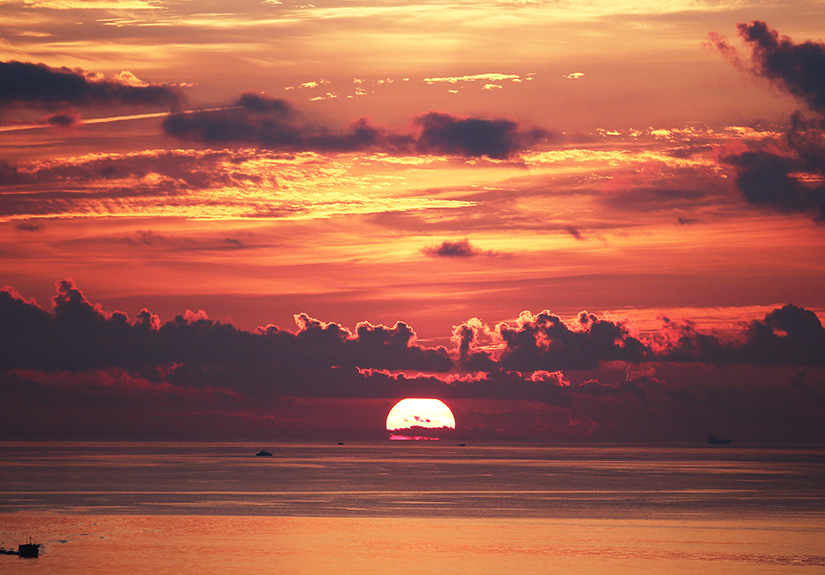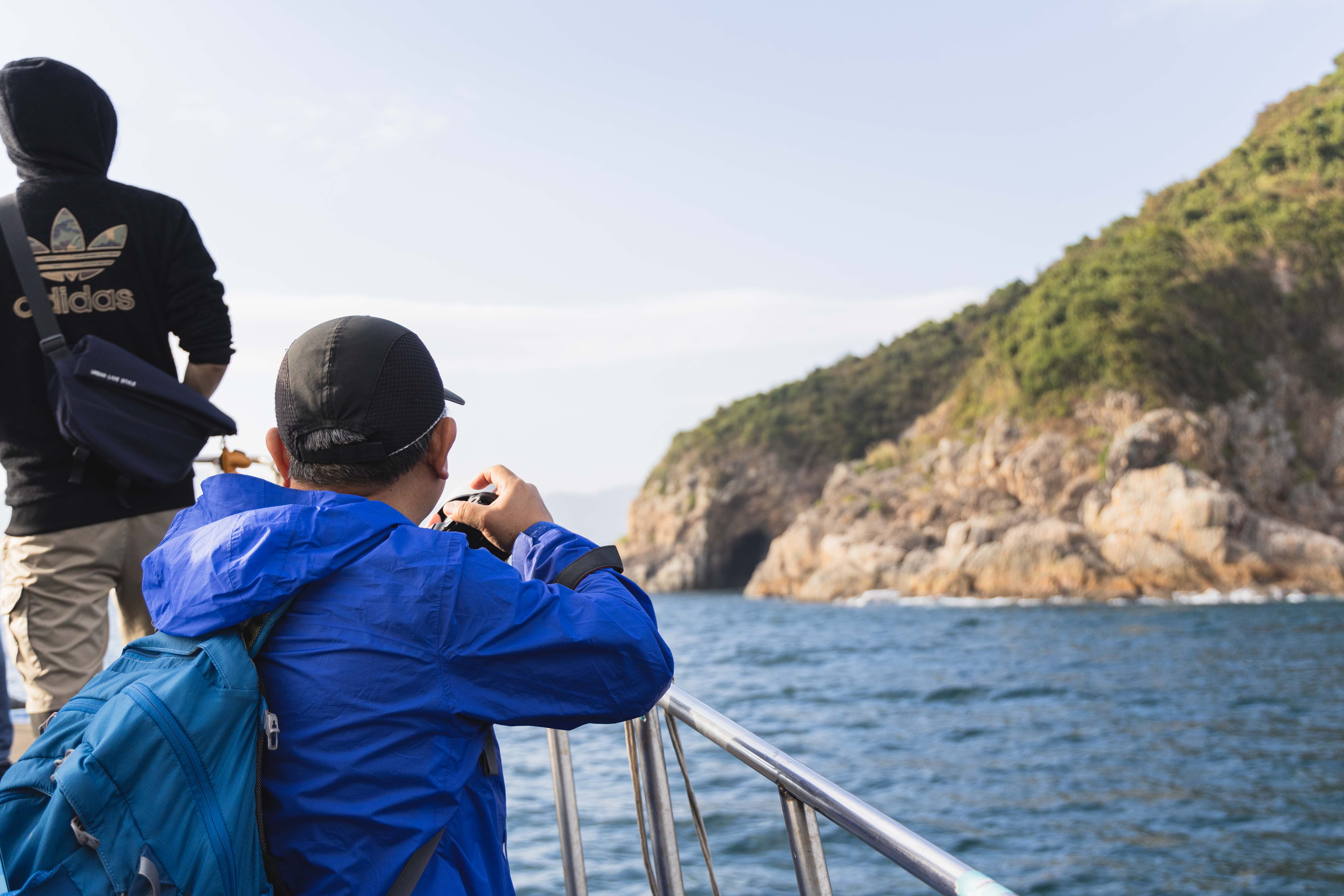Catching the Sunrise
Plan your year in spring and your day at dawn. The light of the morning sun is symbolic of hope, and no wonder it has always been the favorite subject for photo lovers. The keys to capturing stunning shots of the dawn and the rising sun lie in your skills to adapt to the change of light and adjustment on the camera’s white balance setting. The below tips and techniques can also make your shooting a lot easier!
Increase Color Saturation Level for More Stunning Morning Light
Sunrise photography is a competition against the clock. As the sun rises above the horizon in only a few minutes, it is best for us to start shooting an hour prior to the sunrise in order to capture the entire process. At dawn when the sun is yet to rise, the sky shows the richest change of color from dark blue to orangish-red. We should adjust the camera’s white balance setting to Cloudy or Shade to accentuate the warm tone of color and set the stage for the coming sun. Besides, use of Landscape picture style can also increase the color saturation level and enrich the colors of the photo.

Title:《雲南元陽,多依樹梯田,日出》 Club Canon Member:Eddie Wong
EOS 5D Mark II.EF 16-35mm f/2.8L USM.10s.f/14.0.ISO 100
EOS 5D Mark II.EF 16-35mm f/2.8L USM.10s.f/14.0.ISO 100
Use of GND Filter to Reduce Contrast
When the sun is rising from the horizon, its brightness will result in a high lighting contrast between the sun and its surrounding environment. A smaller aperture such as f/10 or above plus a faster shutter should be used for shooting. To faithfully depict the scene of an early morning with fabulous sky colors, try using the clouds next to the sun as the metering points to determine the final exposure setting. As the light changes rapidly during this period of time, we should have our cameras keep doing the metering from shot to shot to ensure proper exposure.
To retain details for both the sky and the foreground, we can either use the in-camera HDR mode or a Graduated Neutral Density filter (GND filter) to balance out the contrast between the sky and the foreground. When taking photo at the moment the sun is out, we can use Reverse GND to cover the sky with the gray portion to combat the problem of high lighting contrast.
To retain details for both the sky and the foreground, we can either use the in-camera HDR mode or a Graduated Neutral Density filter (GND filter) to balance out the contrast between the sky and the foreground. When taking photo at the moment the sun is out, we can use Reverse GND to cover the sky with the gray portion to combat the problem of high lighting contrast.

Title:《大帽山日出》 Club Canon Member:Adrian Chan
EOS 70D • EF-S 18-135mm f/3.5-5.6 IS STM • 1/125s • f/11 • ISO 100
EOS 70D • EF-S 18-135mm f/3.5-5.6 IS STM • 1/125s • f/11 • ISO 100
Small Aperture to Capture Crepuscular Rays
Don’t feel defeated even if the day is humid and cloudy, as when the sun rises to a higher position, there are chances to capture what we called “Jesus Rays” – the unique and beautiful scenery when the sun rays stream through edges or gaps in clouds. To take photos of crepuscular rays, use a small aperture such as f/8 or above to freeze the details from near to afar. To learn more about this kind of shooting, please read another article on “In Chase of Holy Light and Shadow – Shooting Tips for Crepuscular Rays”」.

Title :《雲海上的鳳凰》 Club Canon Member :Thomas Wong
EOS 6D • EF 24-105mm f/4L IS USM • 1/800s • f/8.0 • ISO 400
EOS 6D • EF 24-105mm f/4L IS USM • 1/800s • f/8.0 • ISO 400

Title :《晨光暖立山》 Club Canon Member :Wilson Au
EOS 5D Mark III • EF 24-85mm f/3.5-4.5 USM • 1/80s • f/8.0 • ISO 100
EOS 5D Mark III • EF 24-85mm f/3.5-4.5 USM • 1/80s • f/8.0 • ISO 100
Slow Speed Shutter to Freeze the Beauty of Morning Fog
Morning fog is another subject to shoot during sunrise. The thin layer of mist covering the landscape will look translucent in the photo under the warm morning light coming from an angle, which can help depict the mood of a serene morning. Fog is actually a collection of flowing liquid water droplets. To capture its beauty, we should use a slow speed shutter such as 1/5s and shoot on a tripod. For composition, choose a darker background as possible to complement the white fog. Since a misty scene is low in contrast, adjust to a smaller ISO setting in order to maintain richer gradation. If the fog takes up a large proportion of arae in the frame, we may need to increase the exposure compensation to avoid under-exposure.

Title :《晨霧中的禾木鄉》 Club Canon Member :Henry Lau
EOS 500D • EF-S 18-135mm f/3.5-5.6 IS • 1/5s • f/20 • ISO 100
EOS 500D • EF-S 18-135mm f/3.5-5.6 IS • 1/5s • f/20 • ISO 100

Title :《深秋晨曦》 Club Canon Member :Nelson Choi
Canon EOS 5D Mark III • EF 16-35mm f/2.8L II USM • 25s • f/9.0 • ISO 800
Canon EOS 5D Mark III • EF 16-35mm f/2.8L II USM • 25s • f/9.0 • ISO 800
Use of Foreground Elements to Create Mood
Don’t frame your shots the exact same ways as others. Use of different foreground elements can give your photos a different look and feel. For example, in the first photo shown below, the photographer captured the moment when hundreds of hot air balloons flight up in the air as foreground to complement the sunrise scene. In the second photo below, the stunning sky colors reflection in the water was ingeniously captured to create an interesting image of reality versus illusion. Both photos were taken at dawn but distinctive moods were created. Try exploring different compositions to create more one-of-a-kind photo results!

Title :《奇石林 • 早安!》 Club Canon Member :Mike Leung
EOS-1D X • EF 24-70mm f/2.8L II USM • 1/50s • f/8.0 • ISO 100
EOS-1D X • EF 24-70mm f/2.8L II USM • 1/50s • f/8.0 • ISO 100

Title :《南生圍之晨》 Club Canon Member :YIK CHIU
EOS 6D • EF 24-105mm f/4L IS USM • 1/3s • f/22.0 • ISO 100
EOS 6D • EF 24-105mm f/4L IS USM • 1/3s • f/22.0 • ISO 100
Recommended Sunrise Shooting Locations
There are many places in Hong Kong for sunrise photography. Places at high altitude, facing east and with wide-open views are good locations. To be more specific, Tai Mo Shan, Lantau Peak, Sunset Peak and Ngong Ping in Ma On Shan are good for dawn and sunrise photography, and there are high chances to capture shots of sunrise above the sea of clouds and morning fog. Places around the eastern coastline such as Cape D'Aguilar, Sai Kung Pier and Grass-Island offer scenery of the sun rising from the sea surface with rich gradation of light colors.



